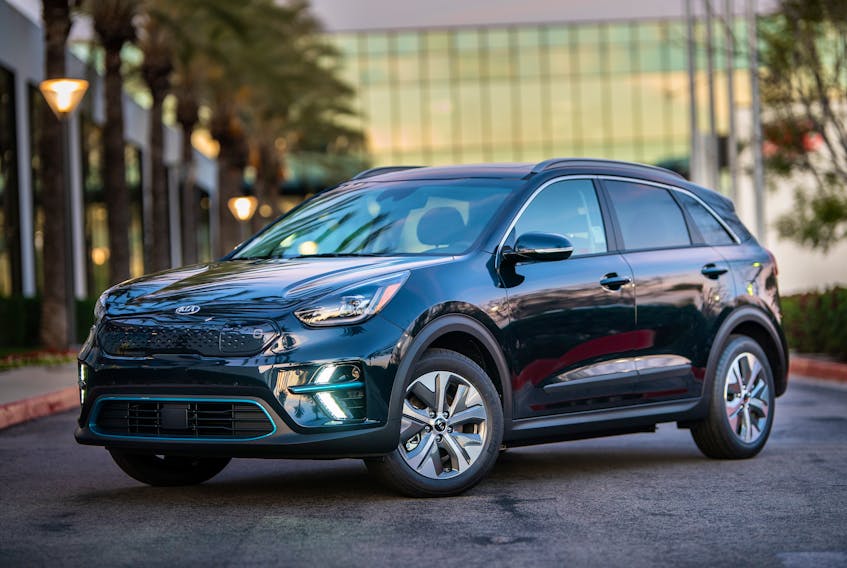Electric vehicles are coming. Elon Musk and Tesla have shaken the industry, most recently with sales finally meeting projections and the opening of a factory in China. All the big names in the industry globally are in the game. Aside from Tesla there are also some new players, chief among them — in my opinion — is Rivian. The Michigan-based company is well on the way to producing the first electric pickup with more than US$1 billion in investment from Ford, Amazon, a giant U.S. dealer group and others.
All the media attention has been focussed on Tesla, Rivian and a Mustang-labelled crossover from Ford. In the meantime, pure electric vehicles from Hyundai and Kia have been appearing on roads in Asia, Europe and North America. These are not pre-production or one-off efforts. They are series-production vehicles offering all the features of a “regular” car, with a purely electric drivetrain.
I reviewed the Hyundai Kona a few months ago. Now, let’s take a look at its kissing cousin, the Kia Niro EV. Like the Hyundai, the Niro EV is a sophisticated, fully-engineered and well-executed vehicle that makes electric ownership not only more affordable but requires no sacrifices. This is a compact crossover that can stand on its own in a face-off with any conventional compact ute.
The Niro can run up to 375 km on a single charge. With the abundance of instant-on, low-end torque offered by electric motors, it will scoot almost silently from rest to 100 km/h in less than seven seconds and cover the quarter mile in 15 seconds flat. Those numbers may not mean much to most consumers, but they tell us the Niro will keep pace with or outperform anything in the class.
Aside from the thoroughness of the engineering, what I find most impressive about the Niro is practicality. The interior is clean and simple. The materials, other than a bit of black plastic, are of high quality. The front seats are supportive for long periods and, because the wheelbase is a few inches longer than that of the Kona, there is more rear seat and cargo space. Because of where the battery pack is positioned, the floor under the rear seats is slightly higher than “normal” causing passengers knees to be raised slightly.

From behind the wheel, the Niro feels like a regular car. Put it in gear, press the gas (oops, accelerator) pedal and go. The steering is light and direct with decent feedback. The suspension soaks up both major and minor road blemishes with ease. The only sign there is anything different is a slight sponginess to the brake pedal. This is due to a sophisticated regeneration system that converts the heat generated into electricity to recharge the batteries.
The Niro EV comes in two trim levels and both are extremely well-equipped. The SX Touring unit I drove came with LED headlights, sunroof, heated mirrors and steering wheel, heated front and rear leather seats, cooled front seats, tilt and telescope steering wheel, automatic climate control, 20-cm infotainment screen, Harmon Kardon audio system, Apple CarPlay and AndroidAuto integration, wireless phone charger, 110-volt household outlet, smart cruise control, power windows and locks and UVO services.
Recharging via a fully depleted battery pack from a 240-volt Level 2 station takes about nine hours. If you can plug into a 100-kW fast charger you’ll get back to 80 per cent of charge in one hour.
The Kia Niro EV is a practical compact crossover that happens to have an electric motor. It's never been easier to switch to an electric car. If you can find one.
Before you go rushing off to the nearest Kia store with deposit in hand, be aware you won’t find a Niro. The one I drove was a 2019 model. Kia is tight-lipped about a 2020 version saying only that it will be available with little or no change. The problem Hyundai and Kia face is a short supply of batteries. The limited quantity means the Kona and Niro are only available in states where EVs have been mandated, and in provinces where incentives are in place to reduce the cost. They are eligible for the new $5,000 federal grant.
The specs
Model: 2019 Kia Niro SX Touring
Engine: 150 kW permanent-magnet synchronous AC electric motor, 64 kWh liquid-cooled lithium-ion polymer battery — 201 horsepower, 291 lb.-ft. of torque
Transmission: single speed, direct drive
NRCan rating (litres/100km city/highway): N/A
Length: 4,374 mm
Width: 1,806 mm
Wheelbase: 2,600 mm
Weight: 1,781 kg
Price: $44,995 base (EX), $56,090 as tested (SX Touring), includes freight
Safety features: blind spot detection, lane keep assist, forward collision warning, front and rear park sensors, rear cross traffic alert, rear-view camera
Options on test vehicle: none









